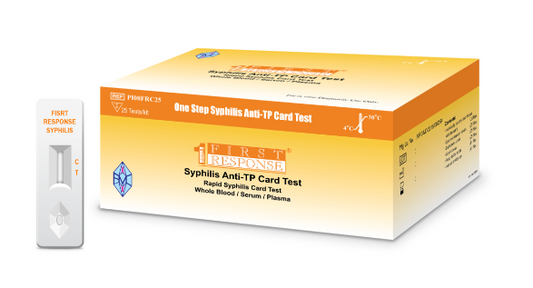-
First Response HIV 1+2 / Syphilis Combo Card Test (Professional)
Vendor:Premier Medical Corporation Private LimitedRegular price $0.00Regular priceUnit price per -
First Response Syphilis Anti-TP Card Test (Professional)
Vendor:Premier Medical Corporation Private LimitedRegular price $0.00Regular priceUnit price per
Collapsible content
What is syphilis?
Syphilis is a bacterial sexually transmitted infection (STI) caused byTreponema pallidumwhich results in substantial morbidity and mortality, and it is curable. Syphilis is transmitted through sexual contact with the infectious lesions, via blood transfusion or from a pregnant woman to her fetus. Mother-to-child transmission of syphilisis usually devastating to the fetus in cases that were not detected or treated sufficiently early in pregnancy. Maternal syphilis, when untreated, treated late or not treated with penicillin, results in adverse birth outcomes (ABOs) estimated in 50−80% of cases, depending on the stage of syphilis. These ABOs are often severe and include stillbirth (most commonly), neonatal death, prematurity, low birth weight, and congenitally infected infants.
(Global health sector strategies on, respectively, HIV, viral hepatitis and sexually
transmitted infections for the period 2022-2030. Geneva: World Health Organization; 2022)
How to prevent, screen and diagnose syphilis?
Syphilis can be prevented through safer sex practices including the correct and consistent use of condoms. Many people with syphilis do not have any symptoms or have only minor symptoms that go unnoticed. Identifying infection through laboratory tests and treatment of positive cases will prevent further transmission and adverse pregnancy outcomes including congenital syphilis. Screening can be done using rapid tests that can provide results in less than 20 minutes, allowing for immediate treatment.
(Global health sector strategies on, respectively, HIV, viral hepatitis and sexually
transmitted infections for the period 2022-2030. Geneva: World Health Organization; 2022)
What is the WHO impact indicator for syphilis?
In 2020 the WHO estimated that 7.1 million new cases of syphilis, the target is a 90% reduction in the number of new cases of syphilis and gonorrhoea as well as 50% reduction in the number of new cases of chlamydia and trichomoniasis by 2030.
This includes the triple elimination of vertical (mother-to-child) transmission of HIV,
syphilis and hepatitis B virus by delivering comprehensive and accessible prevention, testing, treatment and follow-up services for women, children and their families through an integrated approach with maternal and child
health services and promoting gender equality and human rights.
(Global health sector strategies on, respectively, HIV, viral hepatitis and sexually
transmitted infections for the period 2022-2030. Geneva: World Health Organization; 2022)







